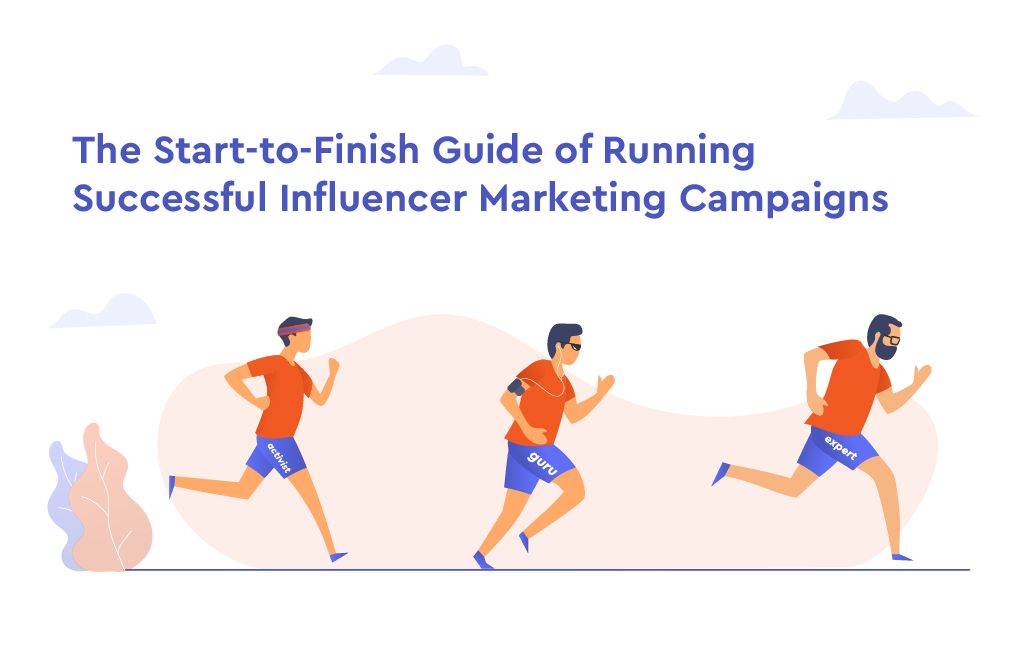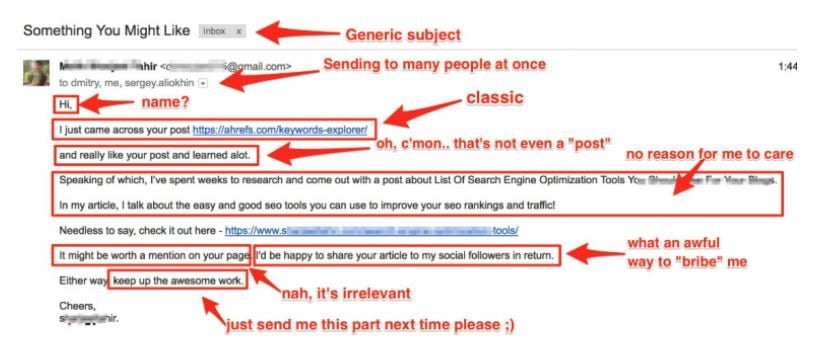Determine Objectives
Like any other type of marketing, influencer marketing isn’t something that you can do ad hoc, based
solely on your gut feeling. There is little to no point taking on influencer marketing without having a
solid plan first.
Numerous brands fail with their influencer marketing efforts mainly because they refuse to plan ahead and
set objectives for their campaigns. All they basically do is chase influencers with big followings on major
social networks and offer them money and products in exchange for a couple of promotional posts.
This type of approach rarely results in success.
Even though a significant percentage of them end up generating at least some engagement, the vast majority
doesn’t really know what to do with it. It’s just traffic that comes and goes.
Nothing more than that.
It’s not something that you can capture, maintain, and direct in the desired direction.
This is not the right way to do influencer marketing.
If you want to win big with this practice, you need to have a solid reason for doing what you’re doing.
What do you want to achieve with your efforts in this department? It could be something simple, or something
more complex.
It all depends on what’s your end-goal.
When partnering with influencers, most brands focus on:
- Increasing their website visits by a specific percentage
- Increasing their social media following
- Increasing their brand awareness
- Generating more leads and sales by a specific percentage
Whatever your core objective may be, it’s always important to have one. You need to have a general idea of
why you’re investing in influencer marketing in the first place and what you’re looking to get from your
efforts.
This will affect how you measure the success of your campaigns and select with which influencers you’re
going to work with on specific projects.
For example: If you’re looking to start some quick buzz online and get people talking about your new
product, you will most likely reach out to influencers that have large followings on Facebook and Twitter.
If your desire is to create in-depth awareness and shape the opinions of people regarding the value and
authenticity of your product or service, you should partner up with influential niche bloggers or relevant
media sites who have a lot of authority and respect in the industry.
It is of utmost importance to closely tie your goals to your key performance indicators. For instance, if
you have a goal of increasing your social following, you should know the exact number of your followers
before and after partnering with an influencer. If you don’t define the KPIs for measuring your efficiency,
you will face extreme difficulty determining the exact success rate of your influencer campaigns and
collaborations.
You need to create intelligent goals and KPIs. Period. This is the backbone of influencer marketing. They
have to be specific, realistic, measurable, achievable, and time-based. The goal of “increasing sales and
leads” is too vague. On the other hand, “growing your sales and leads by 20% in August” is something that
you could see achieving and use it as a bar for understanding the efficiency of your influencer marketing
campaigns.
Find Your Audience and Strategically Select the Right Channels for Your Influencer Marketing Campaigns
Once you have an idea of what you want to achieve via your influencer marketing, you need to figure out
who you’re going to target and why. It is impossible to find the right influencer if you don’t know in
advance who you want to influence.
In case you don’t already have an ideal customer persona in mind, now is the time to work on that.
Regardless of what your goal is and what tactics you deploy to get more people to notice your brand online,
everything still boils down to that same skill of understanding how your most valuable users think and
behave.
If you don’t know who your ideal users are, how they tick and operate online, you won’t be able to spark any
interest from them, which means that all of your influencer marketing efforts will bring you zero ROI. You
won’t know what strategies or networks to choose, let alone how to select the right influencers to help you
grow your exposure and generate more leads and sales.
If you don’t know who you ideal consumers really are, there are few ways you can find out:
-
You can open your Google Analytics account and check the demographics of people who are currently visiting
your site and converting through via your blog posts, ads, or pages
- You can do surveys
-
You can look through your contacts database to uncover trends about how people find and consume your
content
-
You can take into consideration your sales team’s feedback on the leads they interacting with the most
- You can talk to active consumers to see what made them do business with you
There is a simple formula for defining your audience and figuring out who to target with your marketing
efforts.
It goes like this:
[YOUR BRAND NAME] creates [PRODUCT AND SERVICE] to help [ACTION] do better.
Filling in the empty spaces in this simple formula will definitely guide you in the right direction when it
comes to understanding your ideal consumers.
The idea here is to take a deep dive into the details:
- Age
- Gender (if your product is gender-exclusive)
- Job
- Outlook on life
- Interests
- Location
- Education
- What problems do they face and how your product can help them live better
Once you have all that, you can move on to the second phase of the process. When you know everything there
is to know about the people who you’re looking to engage, finding the right influencers for your campaign
immediately becomes a significantly easier process.
For influencer marketing to be successful, you have to partner up with influencers who influence your ideal
consumers.
For instance, let’s say that you have a large marketing budget and that you can afford to work with LeBron
James on an influencer marketing campaign. That doesn’t necessarily mean you should do that.
If you’re selling sportswear or something related to basketball, LeBron would clearly do an excellent job of
marketing your gear for you.
However, if you have a product like Base, a marketing utility that’s designed to help agencies and
independent marketing professionals remove the pain and unnecessary manual steps from the process of link
building - partnering up with a basketball superstar just doesn’t make any sense.
Sure, a lot of people will see your brand and product online, but 99 percent of them will completely ignore
it because it has nothing to do with their interests.
The more you can narrow your market to a specific niche, the easier it will be to search for the right
authoritative figures to help you promote your brand and products.
Finding the right influencers for your brand is more complicated than it seems. A recent study confirms that
more than
67 percent of marketers struggle to pick the right influencers for their campaigns.
Finding influencers whose audience matches your target market is one of the most important components to
running successful influencer marketing campaigns.
Types of Influencers
Before we can start searching for influencers that perfectly fit our brand and campaigns, we first need to
understand more about the influencers as public figures.
There are three major groups of influencers:
- Celebrity influencers
- Macro-influencers
- Micro-influencers
Every group brings a different set of perks
Celebrity Influencers
Celebrity influencer is a pretty self-explanatory term. This is the oldest type of influencer marketing.
Companies like Nike, Adidas, and many others have been hiring celebrities for years to endorse their
products and build better brand and product awareness.
Some celebrity campaigns have been so successful that they have become synonymous with the celebrities who
promoted them. For example, Michael Jordan’s partnership with Nike quickly became so iconic that Nike
decided to transform Air Jordan’s into a stand-alone brand.
However, it’s not all sunshine and roses when it comes to working with celebrities. There are certain pros
and cons you need to consider before partnering with a celebrity to promote your products for you. Some
celebrity campaigns have created more problems than good for both involved parties.
For example, Kim Kardashian was fined a quarter of a million dollars for posting a single Instagram photo
on behalf of one brand.
The main issue with celebrity influencer marketing today is that people are growing suspicious about
celebrities promoting items and services they don’t personally use. If you have the money to pay someone
famous to endorse your brands, service, and products, make sure that your influencer is 100 percent on board
with your business. If you don’t establish a believable connection, the whole campaign will bring zero value
to your business.
For instance, would anyone really believe that a guy like Michael Jordan is super into your fishing gear?
Would it matter if the greatest basketball player of all time promoted fishing hooks and rubber boots? - I
think not. It’s just not relevant.
Sure, you can make a super fun ad or post with MJ which might get you a bit of exposure online, but your
efforts here won’t really change the buying behavior of the targeted audience.
When it comes to celebrity influencer marketing, the best plan here is to find the people who are willing to
become your genuine brand ambassadors. The main reason why Air Jordan’s took off as a brand is because MJ
was actually wearing the gear. Same goes for Cristiano Ronaldo who currently has brand ambassador deals with
Nike, Tag Heuer, Sacoor Brother suits and Monster headphones. He actually wears the gear and can be seen and
photographed in public using/wearing his sponsor’s products.
Macro-Influencers
Macro-influencers are people with large online followings. They are usually considered to be experts in
their own field. The difference between celebrity influencers and macro-influencers is that
macro-influencers are usually just popular online in their own industry, while celebrity influencers are
recognizable across multiple channels and mediums.
For instance, Rand Fishkin built a recognizable name with a lot of credibility, but only within the digital
marketing industry. Outside of it, people don't know who he is or what he does. Same goes for Brian Dean,
Jay Baer, and Neil Patel.
If you have a service or a product that helps people with their digital marketing, you would receive more
value working with these niche authority figures than with celebrities like Zac Efron, Emma Stone, and
others. An endorsement from the likes of Rand Fishkin and Brian Dean could instantly build your credibility
and help you get your name in front of the right people.
However, getting macro-influencers to work with you is never an easy task. You have to offer them something
exciting to even consider promoting your brand to their audience.
They have already made a name for themselves in the industry, so most of them aren’t really open to doing
anything that has any chance of harming their credibility. They are the top dogs in their niche, so they
don’t really have to do anything they don’t believe in just to make a bit of money on the side.
In my experience, macro-influencers work with new brands only when:
- They are pitched something that truly blows their mind
-
When they are invited to collaborate on big researches and studies that could underline their expertise
even more
- They genuinely love the product or mission of the brand that approaches them
- The brand offers something that could help them look cool
Micro-Influencers
This is the largest group on the list. Micro-influencers are basically scaled-down versions of
macro-influencers. They don’t have an insanely large following, nor do any recognition outside of their
niche and market. These are people who shape and influence the opinions of smaller groups of users, in the
range of 1000 to 10000 people.
Micro-influencers are often just bubbling under the macro-influencer level. A lot of them aren’t really that
big because they have a more narrow focus on the topic and niche.
Depending on the industry and the people who actively follow their work, micro-influencers can be extremely
useful. A vast number of them have personal connections with their followers which means that they have a
lot of insights into their audience’s needs and preferences.
That is why it's often better to partner with micro than with macro-influencers. They have a much more
significant support base than the average user, but they’re also a lot more flexible than macro-influencers.
They are open to new partnerships, and they don’t charge nearly enough as the first two groups of previously
mentioned influencers.
Even though they don’t really have a lot of fans, micro-influencers often have high engagement rates. Their
audience recognizes their expertise and keeps coming back for more. They have become fervent supporters of
the influencer’s work.
When it comes to running successful influencer marketing campaigns, follower count shouldn’t be a decisive
factor. A lot of people still buy followers in order to pump up their network and make their brand look
bigger than it really is. Apart from selecting the right influencers that are in perfect sync with the
brand, products, or services you’re promoting, you should also take the time to study the influencers’
engagement rates. Look beyond traffic, likes, and share. Focus on comments and how people truly interact
with their content.
Strategically Selecting the Right Channels
Once you have your goals set and you know the exact type of audience you’re interested in pursuing, it’s
time to strategically select the right channels for your campaigns.
Every channel brings different values. Running a campaign across multiple channels is not really a bad idea,
but most brands don’t really have that big of a budget to spread their message everywhere. If you operate on
a limited budget, you need to strategically pick the channel and type of content that will most likely bring
you the best ROI.
For instance, if you’re planning to promote a tool like Base via influencer marketing, it’s in your best
interest to look for influencers who can actually make a case for your product. You need people who run
authoritative blogs and write articles on the topics of SEO and digital marketing.
Getting a tweet from the likes of Rand Fishkin about your product isn’t really a good strategy for you,
especially if your product requires a bit of explaining and demonstrating before someone can successfully
use it. Of course, this doesn’t necessarily mean that a tweet from Rand won’t work, but experience has shown
that our targeted audience is far more interested in reading blog posts instead of tweets.
Sure, it might cost you more to publish an article on a popular industry blog, but you have to think a
couple of steps ahead and calculate which channels will work best for you.
Different products and brands require different approaches to influencer marketing. In some cases, an
Instagram post from the right influencer can do a lot more good for you than 10 blog posts. But in other
situations, it can be a total waste of your resources. The point is: Every product is different and it
requires a unique approach. You cannot really push a link prospecting utility the same way as you push a
clothing brand online. One is all about aesthetics, while the other is about removing the pain from the
process, so it requires a deeper approach where you can actually demonstrate how it works.
Determining the Idea Influencer Persona
Just like with your audience, you need to develop an ideal influencer persona for your campaign before you
start outreaching to people. It’s in your best interest to find people who not only have the exact
audience you are after, but also share your company values.
When creating an ideal influencer persona, you should focus on the following:
-
Personality type:
Are you in need of an activist, authority business figure, knowledge leader or someone even more
specific? It is of great importance to find a person who people could see as a user of your products and
services.
-
Genre:
Are you looking for a male or female influencer, or both? This is especially important for gender
exclusive brands. If you have a makeup company, you don’t really want an NFL star to promote your lip
balm.
-
Niche: You can choose one or more niches, but they have to be relevant to your brand. For
instance, in order to promote Base, I usually target SEO and digital marketing influencers
who run authoritative industry blogs because my ideal customers are SEO agencies and freelancers who are
always looking for good products that could help them save time and money on mundane tasks.
-
Topics: If you want to get a lot out of your influencer collaborations, you need to find a topic
that’s close to them. For instance, if Brian Dean is known for his articles on the topic of building
links, it would be dumb for me to ask him to write a post about Base from a influencer
research angle. You need to find a topic for which both you and your targeted influencer care about. In
order for your collaboration to make sense, it has to look like an organic fit.
-
End-goal:
What do you want to get out of your influencer collaboration? Better social following and awareness?
More site visits from relevant audiences? Are you building authority in your niche by partnering with
the best bloggers? Do you have a visually driven campaign and you need influencers who are big on
Instagram? Is it the quick Twitter buzz you are after?
Whatever the type of engagement you’re looking for, the idea is to narrow down the channels and the number
of followers on those channels you’re going to target. Take every single one of these elements into
consideration when searching for influencers to partner with for your campaigns.
How to Integrate Influencers in Your Campaign
There are different levels of influencer involvement. Some marketing campaigns are solely
influencer-based, while others play a smaller role in a bigger strategy.
Before you contact anyone to help you promote your brand, you need to decide upfront what level of
involvement you’re willing to offer. You could choose to incorporate influencers into every stage of your
campaign, from market research to execution. Some campaigns use multiple channels to spread the word and use
social influencers as just one of many tools to accomplish their ultimate end-goal.
It all depends on what you want to achieve. It is important to figure this out before you move to the
following phase of the process.
Finding the Right Influencers to Help You Meet Your Goals
Once you figure out the specific type of promotion you’re looking for and you develop an ideal influencer
persona, it’s time to search for influencers that can help you spread your message accordingly across the
Web.
There are literally dozens of ways you can search for influencers. You could start with a simple Google
search for relevant keywords (like “link management”, “link building tool” for Base), or you
can use a wide variety of tools that specialize in finding influencers for your campaigns.
Dibz is one of those tools. We published a case
study (on Dibz’ blog) in which we wrote about how our utility helped us find more than
2000 DACH influencers in record time
for a client, even though nobody on our team speaks fluent German.
Regardless of the fact that Dibz is primarily a link prospecting tool, it can also be used for
different types of data mining, such as, in this particular case – influencer research.
The tool makes it possible for the users to scrape the Web using predefined and custom search parameters.
All you have to do is:
- Open the tool
- Write down the keywords in the search term field
-
Enter the parameters for your search (since we had to classify the blogs according to the country in our
above-mentioned case, we specified the type of websites we were after, as well as their TLD)
- Set the date range, depth, and language
And voilà - the tool will immediately start scraping the Web in accordance to your parameters, providing you
with a list of relevant results in just a couple of minutes!
This is just one of many ways to look for influencers online.
You could also do it by:
- Paying an agency to do it for you
-
Using one of many patented platforms that help users discover people they believe are the influencers for
their audience (Deep Social,
Klear,
Discover.ly, etc.)
- Searching manually for people on LinkedIn, Instagram, and Twitter using keywords and hashtags
-
Using tools like BuzzSumo,
Hey Press,
Ahrefs Content Explorer, and many others
who fall under the same category.
Searching for influencers is not really hard once you understand what type of audience you’re interested in
pursuing. If you have a lot of data on your hands, you’ll easily find people who fit your mission and brand
online.
Remember to always look beyond the number of followers and site visits. We at Four Dots look at our
prospects from various different angles before marking them down as potential influencers for our campaigns.
Our agency staffers analyze the actual engagement of particular influencers. We look at their last 5 posts
in order to determine their current status. Our staffers look at social shares, links, and comments. We also
try to figure out if the influencers actually communicate with their audience or do they just ignore their
messages.
In our eyes, engagement is the only real metric that separates good from bad influencers. We tend to select
people with smaller following that have better engagement rates before influencers who have insanely big
networks but who aren’t in touch with their followers.
Influencer Outreach
This is where things get a bit complicated. One of the main reasons why people hire agencies to handle
their influencer marketing for them is because someone else gets to do the outreach part of the process.
Businesses frequently reach out to
Four Dots to perform this mundane task for them.
Outreach can be a tricky game. Apart from being slow and exhausting, outreach is also an extremely delicate
part of the puzzle where one wrong line could multiply all your prep work with zero.
If you don’t want to partner up with an agency and you wish to outreach to influencers on your own, there
are certain things you need to have in mind before sending an email.
Not that long ago, I wrote a
separate article on this topic. In that blog post, I pointed out that, regardless of how good and experienced you are, sending outreach
emails will always be a gamble. There’s no one-size-fits-all model which can guarantee you that the people
you reach out to will see and reply to your emails. Even though there are certain marketers who maintain a
decent success rate in this field, everything still boils down to pure dumb luck.
Why? - Well, because when you’re sending cold emails you can never know who’s receiving them at the other
end. Even if you do your research well and create a personal email for each and everyone one of your
targeted influencers, there’s still a legitimate chance that your messages will get ignored.
Sure, you may know their name and credentials, but you still don’t really know them as people. You still
don’t know if they, for example, hate receiving cold emails or not. You don’t know what they like and
dislike. Maybe you’re reaching out when your recipients are on holiday, so they don’t feel like talking
business while they’re chillin’ on the beach. Maybe you’re using the wrong tone in your messages. The
possibilities are endless. These are just some of the things you can never really know about your prospects
in advance.
Of course, there are certain tricks and tactics that could significantly increase your chances of getting a
response from your targets, but at the end of the day - it’s all about sending the right email to the right
person at the right time.
When it comes to outreaching to influencers, you should focus on the following:
Finesse and Personalization
If you’ve read our previously-mentioned article on the topic of outreach, you might have noticed this
screenshot:
Tim Soulo from Ahrefs shared this example on his private Twitter account. As you can see from the image, Tim
framed and pointed out every mistake the sender made while reaching out to him.
The biggest problem here definitely originates from lack of personalization. A lot of people still send
their outreach emails in bulk. They often rely on generic and uninspiring hooks to get people to respond to
their messages.
Judging by Tim’s reaction, it’s safe to assume that influencers despise this particular approach. If you
want an influencer to really sit down, read, and respond to your email - you need to put in the work and
create something personal and inspiring. You need to be sincere and provide the influencer with enough
evidence that you deserve his or her time and attention.
Be Concise
There’s no need to get overly descriptive in your outreach emails. Especially if you’re trying to engage
someone who you know for a fact is constantly busy.
Most successful outreach emails are the ones that get straight to the point and immediately make it
transparent to the recipient why he or she should consider your proposal. There’s no need to get super
salesy here. Your recipients already know the game, so it’s in your best interest to avoid “selling ice to
Eskimos” and get straight to the point.
Visualize your outreach emails as elevator pitches. You have 20 to 30 seconds to get someone interested in
your idea. You have to secure your sale just before the elevator stops and your prospect gets out on the
floor. That’s why your outreach emails have to be interesting, memorable, but also succinct as well.
Add Value
Money isn’t the only factor when it comes to partnering with influencers. Regardless of who you’re trying
to reach, it’s important to know that EVERYONE loves a good idea. Especially people who have big networks
to nurture and entertain. If you have something to offer to specific influencers that will make them look
good and even cooler in their audience’s eyes - they’ll agree to work with you.
The challenge here is to come up with something great and communicate it correctly via email.
Influencers with huge online followings are in constant need of top-quality content and campaigns that have
the potential to grow their authority and recognition even more. Even though they are often hard to impress,
there’s always a gap somewhere that needs filling.
Research your idea well before pitching it to your prospect. Be transparent about what exactly you can do
for the influencer you’re trying to engage. Articulate your idea in a way that immediately grabs your
recipient’s interest and makes him or her see that you’re the real deal.
The Process of Crafting the Perfect Outreach
As I’ve mentioned earlier, outreach is a delicate game with a lot of moving pieces.
In my agency, we always first make a list of bloggers and social media stars that match our ideal influencer
persona, and then we start to follow them and engage with their content.
We either:
-
Follow them on every social media channel, subscribe to their blogs, newsletters, and reply to
introductory emails
- Share their content on our private channels
- Comment on their blog articles and social media posts
- Respond to question they ask their followers
- Link them in our posts
- Write ego bait posts that have a high degree of probability of provoking engagement from them
We take notes on everything we believe is worth writing down about those specific influencers and their
followers. What type of content works best, how often do they publish, do they reply to social media posts
and blog comments, which are the worst and best-performing posts - basically everything that comes to mind,
that could provide us with genuine insight on how to approach our targets.
Once we build some recognition and make sure that our targets know who we are, we try to reach out to them
and get them to participate in our campaign.
The idea here is to make the email more about them than you. Regardless of how fun or interesting your brand
may be, most influencers don’t really care about you. All they really care about is their image and their
audience, so you better make it your prime objective to instantly communicate how your idea helps them.
In order to do that, you actually have to follow the influencer and understand why people like him.
Anatomy of a Perfect Outreach Email
Having all these elements in mind, the structure of the perfect outreach email looks something like this:
-
Create a short, but sweet subject line. It should be vague enough to pique interest, but also with enough
detail for any personalization to be distinct. For example: “Interested in partnering with us on [TOPIC
THAT THE INFLUENCER CARES ABOUT] project?”
- Explain the benefits of your proposal
- Provide the specifics
-
Add a deadline to provide the recipients with an understanding that they should respond to your email
ASAP.
Begin your email with a friendly greeting. Something nonchalant works best here. Don’t go overboard, keep it
simple and short. Keep the general tone friendly, but professional. Avoid using any overly salesy phrases -
you don’t want your emails to end up in the spam bin.
Write a sentence or two about yourself, or just sign off at the end with your name and role in the company.
Cut all the fluff out and provide influencers with short and easy-to-read sentences that don’t eat up their
time and energy. If the influencer already recognizes your name and you have already interacted with each
other in the past, be sure to mention that.
Write the body of your email just like I suggested above (explain the benefits of your proposal, provide the
specifics, add a deadline), send it, and wait for the response. If you don’t hear anything for a few days,
send a follow-up. If that doesn’t work, mention the influencer on Twitter to remind him that you’re still
waiting for a response.
Content Creation & Collaboration
While working with influencers, it’s in your best interest to always keep in mind what you want to achieve
with your collaboration. In addition to that, it’s also of great importance to think about why you’ve
decided to work with specific influencers in the first place.
That’s right, it’s because of their content and how their audience responds to their output.
Most companies make the same mistake here. They target specific influencers and ask of them to post
something that feels and looks unnatural to them. For example, I constantly see different social media
influencers posting literally the same type of photos with the same descriptions
Personally, I believe this isn't an effective approach to influencer marketing. The key to earning big ROI
through your influencer marketing efforts is authenticity. When influencers are given the freedom to create
promotional content for a brand in their own way and style, it comes across as more believable to the
targeted audience.
Brands need to show more flexibility when working with influencers. Influencers know their audience well, so
it’s quite logical that you let them take the wheel and do their own thing. Let them decide how to promote
your brand. At least, have a conversation and work on the idea together.
However, it’s still important to remain true to your core objectives. Even though you or your influencers
might think something is cool, the post still has to provoke a specific action from the audience.
There’s literally an infinite number of ways you could collaborate with influencers. These are the more
common ones:
- Send free samples in exchange for a shout-out
- Pay for product reviews (This is especially popular with YouTubers)
-
Host giveaways: provide products, services, samples, coupons, and discounts for influencers to share with
their audience
- Run competitions through influencers
- Pay for sponsored posts
- Write guest posts, or do gest vlogs
The options are endless. Every single one of these angles has its own set of pros and cons. Personally, I
like to mix them all together. Naturally, this sort of approach will cost you a lot more money, but I
strongly believe that transforming an influencer into your brand ambassador is the best way to actually get
a completely new group of people to remember and trust your brand.
For micro-influencers, partnering with a brand allows them to elevate the quality of their content. By
giving them a bit of trust and resources, you’re basically helping influencers take that next step to become
even bigger players in their niche. If everything goes well, they will love you for it and become actual
supporters of your brand.
If the particular influencers end up loving working with you, they will organically promote your future
materials pro bono and share your content with their audience. The idea here is to build a bond and then
work hard to maintain it.
How to Run Your Campaigns and Measure ROI
As you know, influencer marketing is a slow process. You need to do a lot of prep work before you can
start to contact influencers and work with them to spread your message across the Web.
There are different types of influencers and all of them can do different things for you. The
one-size-fits-all approach doesn’t apply here. You need to analyze every single one of the influencers on
your list and adjust your goals according to their role in your strategy.
You should look at different factors when determining how much you should pay a single influencer:
- Quality of their audience - how well their audiences match your targeted market?
-
Authority - how big of a figure a particular influencer is in his niche? How often do people share, quote,
and praise his knowledge?
- How good of a fit is the influencer to your brand?
-
What’s the media value of the influencer posts - how often does his content go viral? How often do online
magazines and different websites pick up his content?
Providing answers to these questions will help you calculate how high you should go to acquire the services
of particular influencers.
Once you get specific influencers to agree on the price and partner up with you, it’s time to let them go to
work and monitor their performance. You can follow what they do in real time, or when the campaign is over.
Before the campaign begins you should check these items off your to-do list:
Once the campaign starts, you will follow KPIs and compare them with your goals. The closer you’re to
meeting your goals, the better. If the influencer doesn’t bring you nearly enough value as you’ve projected,
that means that either your goals are unrealistic or that the influencer doesn’t really have any power over
his or her network.
For instance, if your goal is to increase your Instagram following by 20 percent during your campaign, then
you need to know exactly how many followers you had before and after you’ve started working with a
particular influencer. The same goes for leads and sales. If your goal is to increase direct site sales by a
specific percent, you have to know the exact number of direct site sales before and after you started
working with the influencer. You can make the tracking easier by creating a dedicated sales page with the
link for the influencer.
Most brands follow these statistics:
- Reach and engagement for each post
- Website visits after the influencer mentions the brand
- Additional sales generated during the campaign compared to the cost of working with influencers
If you’re interested in just building awareness, you should measure your impressions and site traffic. If
you want to get more conversions, you should monitor your traffic and audience behavior in Google Analytics.
For every goal, there’s a different set of KPIs you should follow. One of the most crucial jobs here is to
keep a close eye on your most important KPIs as the campaign develops. If you tune in from the beginning,
you will have a lot less difficulty understanding how effective certain influencers are. You will see all
the improvements caused by their work and you can even suggest changes to the content and style of promotion
that could help you get even more value from your partnerships.
Closing Words
Thank you for taking the time to read yet another massive article on our website. I hope this guide helped
you understand all the details and elements you need to consider when collaborating with influencers.
As you can see from everything written above, influencer marketing is all about promoting authenticity. You
don’t want to use influencers as just faceless drones for spamming their audiences. No. Your goal here
should be to provide influencers with enough room, flexibility, and trust to create promotional content
that’s in perfect sync with the material they usually distribute via their website or social media channels.
You don’t want to be the black sheep of the herd. Your goal here is to organically appear on popular
channels and reach out to people in a style and language they peffer.
Be sure to do your homework before you actually decide to partner up with specific influencers and run your
campaigns. Follow the steps from this article and I promise you won’t experience any issues with your
influencer marketing.
That’s it for now,
See you soon again,
Rad @ Base.me

 We fixed link building
We fixed link building We fixed link building
We fixed link building We fixed link building
We fixed link building We fixed link building
We fixed link building Use cases
Use cases Outreach
Outreach Buying links
Buying links Selling links
Selling links Features
Features Backlinks Health Check
Backlinks Health Check Link Building API
Link Building API Blacklisted Links
Blacklisted Links Easily Sell Links
Easily Sell Links SEO Metrics by Ahrefs
SEO Metrics by Ahrefs Chrome extension
Chrome extension Link Building Database
Link Building Database Team Management Tool
Team Management Tool SEO Reporting Dashboard
SEO Reporting Dashboard Index Your Backlinks
Index Your Backlinks LB Outreach Management
LB Outreach Management Expiring Links Alerts
Expiring Links Alerts Automatic SPAM Analysis
Automatic SPAM Analysis Link Building Transparency
Link Building Transparency Google Link Index Checker
Google Link Index Checker Manage External Link Builders
Manage External Link Builders
